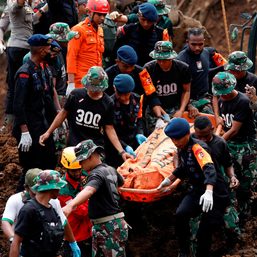SUMMARY
This is AI generated summarization, which may have errors. For context, always refer to the full article.

MANILA, Philippines – Officials from the Office of Civil Defense (OCD) and the Department of the Interior and Local Government (DILG) stressed the urgent need to inspect the structural integrity of key facilities ahead of the “Big One,” a magnitude 7.2 earthquake that could hit Metro Manila if the West Valley Fault moves.
To address structural vulnerabilities nationwide, the DILG announced at the recent 2nd Earthquake Preparedness Summit that it will launch the Harmonized Infrastructure Audit, a tool to establish a unified national standard for assessing public buildings’ resilience against high magnitude earthquakes.
The audit will first be piloted in Calabarzon, the National Capital Region, and Central Luzon.
Fourth and fifth year engineering students from local universities and colleges will also be tapped to assist in the assessments.
DILG Undersecretary Marlo Iringan admitted that a comprehensive audit of critical infrastructure is still incomplete, especially for hospitals, municipal halls, telecommunications hubs, energy facilities, and other structures essential for emergency command and control.
Over 400 public buildings prone to earthquakes in the National Capital Region are currently undergoing retrofitting under the Philippines Seismic Risk Reduction and Resilience Project.
Iringan said the earthquake preparedness summit was timely following the magnitude 7.7 earthquake that hit Myanmar and neighboring Thailand in late March, where the death toll has reached over 3,600.
“It is as if we are given a front-row seat on what happened to both countries…we are jolted back to reality and to the possibility that it could also happen to us,” he said during the summit held on April 8.
In Mandalay, Myanmar, a 12-story condominium with a marketed “earthquake-resistant foundation” built in 2017 collapsed partially due to the March 28 earthquake. Similarly, in Bangkok, Thailand, a 33-story government tower, which was only 30% complete at the time, collapsed, despite being 1,000 kilometers away from the earthquake’s epicenter.
According to experts, Thailand lacked comprehensive safety standards for constructing earthquake-resistant buildings before 2009, which made older structures particularly vulnerable. While newer buildings adhered to updated safety standards, officials speculated that the collapse of the partially completed tower may have resulted from unsafe materials or poor construction planning.
These incidents, according to the OCD, underscore the stakes for the Philippines, where over 168,000 estimated buildings could collapse and 33,000 people could die in a major West Valley Fault earthquake.
OCD chief Undersecretary Ariel Nepomuceno emphasized that structural integrity must be the country’s foremost priority, with buildings needing to withstand earthquakes of up to magnitude 8.5.
He also called out the country’s culture of “shortcutting” construction and permitting processes.
“Kultura ng Pilipino madalas ‘yung may shortcut. Mayabang pa, pinagmamalaki pa kapag naka-shortcut sa pagkuha ng construction at occupancy permits. That should stop,” he said, warning that lax enforcement of building codes puts lives at risk.
(It’s common in Filipino culture to take shortcuts. Some even brag about getting construction and occupancy permits through shortcuts. That should stop.)

LGUs, community trainings
Iringan said that beyond structural audits, grassroots-level preparedness must be prioritized.
Through the DILG’s Operation Listo program, eight disaster preparedness manuals have been developed to guide LGUs and households in early response measures for various hazards.
“Preparedness must be embedded in all phases of disaster reduction and management,” Iringan said.
Iringan further highlighted the DILG’s capacity-building initiatives, especially in barangays within the West Valley Fault zones of the National Capital Region, Central Luzon, and Calabarzon.
Iringan said that in 2024, 91 out of 92 targeted barangays had been trained in basic disaster reduction, focusing on essential skills such as identifying evacuation centers, providing first aid, and managing casualties.
Regions outside Metro Manila are also being prepared to assist in the event of a major earthquake, each assigned to specific response quadrants in the capital.
In 2023, over 600 municipal and barangay disaster risk reduction and management council members were trained in Aurora province. By January 2025, more than 1,800 barangay leaders from the Ilocos Region, Cagayan Valley, and the Cordillera Administrative Region had completed the Agent for Risk and Damage Management training in partnership with the OCD.
As part of enhanced coordination efforts, uniformed personnel from the Philippine Army, Navy, Air Force, Marine Corps, and Coast Guard signed a pledge of commitment last April 9.
They joined other response agencies, including the Philippine National Police, Bureau of Fire Protection, and OCD, under the Republic Act 10121 framework, which strengthens the national disaster risk reduction and management system.
Nepomuceno reiterated that earthquake preparedness must be a shared responsibility.
“We must not leave it solely on the shoulders of the government,” he said. “We have to keep improving our preparations, and we need to generate awareness so that communities pay attention.” – Hannah Andaya/Rappler.com
Hannah Andaya is a Rappler intern studying Communication at the University of Santo Tomas.
Add a comment
How does this make you feel?


![[Be The Good] Water issue has Cavite, Bulacan voters thirsting for change](https://www.rappler.com/tachyon/2025/04/1000010829.jpg?resize=257%2C257&crop=266px%2C0px%2C720px%2C720px)




















![[OPINION] Of intensities, magnitudes and the Rizal Day Bangui earthquake](https://www.rappler.com/tachyon/2024/12/seismograph-adobestock.jpg?resize=257%2C257&crop=271px%2C0px%2C720px%2C720px)














There are no comments yet. Add your comment to start the conversation.